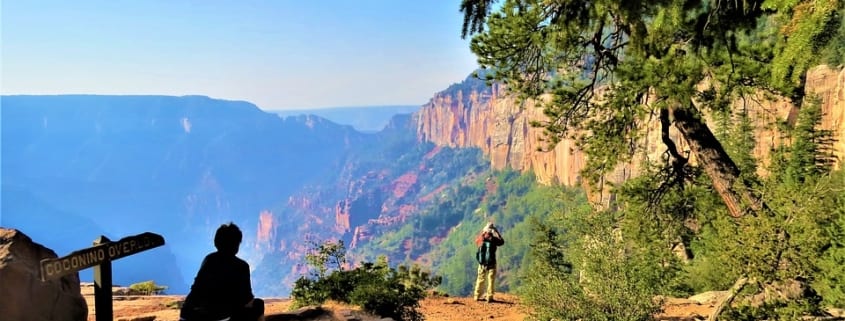Blindness is No Deficiency for These Grand Canyon Hikers
Gabriela Orpinel is like many other women and men who make the rugged hike from the Grand Canyon’s South Rim down to the Colorado River at the canyon bottom and back up again. She is enthusiastic, adventurous, fit, and always ready for a physical and psychological challenge. One difference with most other hikers, however, is that the 42-year-old Gabriela is blind. She made the hike on May 16 with a group of people from the Southern Arizona Association for the Visually Impaired (SAAVI).
Four SAAVI groups undertook and completed the hike on that day. The people in these groups may have been a bit noisier than other hiking groups, because the total or near total blindness of some of the hikers meant that many loud verbal clues needed to be used to navigate the frequently dangerous footing along the South Kaibab trail. The seeing lead hiker of each group called out warnings for obstacles and directions for movement to the other individuals.
Gabriela’s group spent more than 14 hours traveling the difficult 12-mile journey down to the river and back up to the rim. They completed the hike after sunset. Afterward, Gabriela felt exhausted but proud.
“It was so hard,” she said. “I’m just so grateful to the group I was in. They kept me going and going. You have no idea how many times I just wanted to lay down in the dirt, but they just kept saying, ‘Come on, you can do this, you’re strong.’ It’s an amazing feeling.”
Gabriella’s vision became increasingly worse after her diagnosis of glaucoma in 1989. As her sight vanished, so did her participation with the rest of the world.
“I literally sat in my room 24/7,” she recalled. “My children would leave for school in the morning, come back at 3 or 3:30 and find me in my room. I hadn’t eaten, hadn’t showered. I thought that was it as far as my life went.”
Then she discovered opportunities for a renewed active life with SAAVI. The group helped give her a reason to live and to be a fulfilled, happy individual again.
One of the inspirational leaders of SAAVI is Mike Armstrong, the organization’s health and wellness coordinator. The goal of Armstrong, who became totally blind after beginning to lose his sight 20 years ago, is to prove to others than loss of vision does not mean loss of activity or physical fitness. As part of this goal, he organizes frequent hikes at the Grand Canyon. Besides working for SAAVI and being an avid hiker, Armstrong works as a personal trainer and martial arts instructor.
Although the Grand Canyon hikes are among the most challenging of SAAVI expeditions, the organization also participates in less strenuous activities. But the Grand Canyon hikes are special. According to Armstrong, “It might be the thing to motivate some guy who’s been blind for five years sitting in his house thinking he can’t do anything anymore. It might be the thing to get him off his butt and go to school to learn what he needs to get back out there.”
Gabriela Orpinel can testify that Armstrong is right. A little motivation from people who care and understand may be all it takes to renew hope in a person facing serious visual challenges.

 https://pixabay.com/en/hiking-north-rim-grand-canyon-scenic-2420984/
https://pixabay.com/en/hiking-north-rim-grand-canyon-scenic-2420984/
 https://pixabay.com/en/grand-canyon-winter-canyon-snow-2112926/
https://pixabay.com/en/grand-canyon-winter-canyon-snow-2112926/